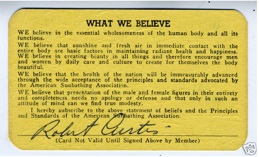HISTORY OF TRAVASUNS & NATURISM
The Long Island Travasuns
Lighthouse Beach Fire Island
A No-Briefs History of Naturism
Definition from the Britannica World Language edition of Funk & Wagnalls Standard Dictionary 1962 edition
Nud-ism ( nõõ′diz·em ) noun
Nudism is the doctrine or practice of living in the state of nudity for hygienic reasons.
Article from Encyclopedia Britannica 1963 edition
(Originally written by Maurice Parmelee)
NUDISM. This article deals with the conscious, intentional movement to practice nudity without separation of the sexes which commenced at about the beginning of the 20th century in the German Nacktkultur (“naked culture”) groups. Prior to World War I they consisted largely of middle-class persons of rather strong nationalistic tendencies. Between the two world wars, the movement expanded considerably not only in membership but in its range of opinions, extending from the most conservative to the most radical. Several books and magazines describing, and some of them advocating, nudism were published.
Mainly following the German example, nudist societies were formed in England, France, Scandinavia and a few other European countries. During the 1930s similar societies were formed in the United States and Canada. The nudist movement was hindered by World War II. It has not made much progress in most of the Roman Catholic and Latin countries.
Nudist groups have been organized as membership societies or as proprietary enterprises. They have dreamed and talked of self-sustaining agricultural and industrial colonies in a suitable environment which would adopt the simple manner of life and humanitarian democracy of nudism. Such colonies as enclaves in a predominantly clothed society are hardly feasible. For the immediate future only private terrains for leisure time and recreational use are practicable. The next step may be the setting aside of some of the public baths and parks for nudist use, as has been done in a few German cities.
Prevailing moral conventions, legalized in many jurisdictions, render it difficult, especially for women, to join nudist organizations While census enumeration of extra-legal groups is not possible, there are probably not more than several hundred thousand such members in the whole world. There is perhaps a somewhat larger number who practice nudism in small family and private groups.
THE RATIONALE OF NUDISM. ----- Man originated as a nude animal, perhaps covered with fur. The habit of clothing the body has varied greatly in time and place. The need for protection from cold climate and from harmful animals and plants, and decoration of the body produced various types of garments.
Cultural evolution gave rise to secondary reasons for clothing. Wealth and property rights attached a symbolic meaning to dress. The garb and ornamentation became indicative of rank and wealth. The apparel has often had a ceremonial and ritual significance. Property rights in women emphasized the concealment of the female body. These factors led to powerful dress conventions, and often to ridicule and persecution of unconventional raiment, and especially of the nude body.
There arose the belief that it is immodest and indecent to expose the human, and especially the female, body, and the sexual organs of both sexes. Shame has usually been experienced at violations of these conventions as to clothing and penalties have been imposed upon such violations.
The nudist movement is a reaction against these dress conventions. Nudists have argued that clothing cuts off the human body from the air and sunlight, and that the practice of nudity is beneficial for health, and thereby improves human beauty. It aids the rearing and education of the young by acquainting and accustoming them to the sexual traits of both sexes, whereas concealment of the body from infancy creates many harmful mental complexes.
Under society’s conventions nudity is forcibly and gratuitously associated with sex in the youthful mind. The practice of nudism aids sex education, is the best preparation for mating and marriage, and is a powerful eugenic factor by uniting the healthiest human beings.
Its advocates hold that nudism creates a higher standard of sincerity and frankness between the sexes, by removing the last artificial barrier. It helps to destroy the notion that sex is peculiarly, and perhaps perilously, mysterious and harmful, especially in women. It weakens sex segregation and strengthens human solidarity. It encourages comradeship between the sexes in work and play, and emphasizes the disutility of clothing in many respects.
Nudism has been criticized and attacked from somewhat different points of view. On the one hand, it is alleged that the sexual areas, such as the pubic hair, the female breasts and the masculine reflex, namely, the penile erection, arouse sexual emotions (in public) and are therefore indecent and unfit to be seen.
On the other hand, it is asserted that the art of dress conceals much ugliness, and enhances the variety and beauty of human existence. Furthermore, nudism, by complete exposure, is accused of decreasing visual sex stimulus, though tactile, olfactory, auditory and gustatory stimuli may be increased. Nudism is therefore alleged to be puritanical and ascetic.
The argument against nudism that the human body, or any part of it, is indecent in the sense that it necessarily and almost inevitably arouses passionate feelings, especially in the male sex, is refuted by nearly every observer of nudist practices. Shame, or a painful consciousness of guilt at the sight of the body, disappears almost immediately. This demonstrates that it is due to artificial modesty caused by prevailing conventions of dress, and is not inherent.
Nudists hold that the movement has psychological and sociological significance for the education of the young and the relations between the sexes, and that it may aid the spread of democracy by eliminating status symbols and artificial insignia of inequality.
BIBLIOGRAPHY,---
Maurice Parmelee, The New Gymnosophy (1927), Nudism in Modern Life (1952);
J.C. Flugel, The Psychology of Nudism (1951);
H. C. Warren, “Social Nudism and the Body Taboo,” Psychology Review (March 1933);
Knight Dunlap, “The Development and Function of Clothing,” Jour. of General Psychology (Jan. 1928)
Under Construction - return at another time

A no-briefs history of
the Long Island Travasuns, Lighthouse Beach F.I.
and Naturism





